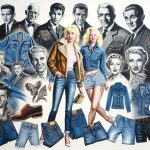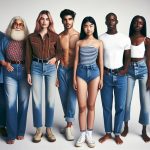Ever wonder why blue jeans have become such a staple in our wardrobes? Sure, they're comfy and durable, but there's so much more to their story. Starting off as workwear, they've transformed into a powerful symbol of rebellion and individuality. Think about it – from James Dean to modern-day influencers, jeans have always had that cool, "against-the-grain" vibe. They're not just pants; they're a statement. But how did we get here, and what exactly makes them tick all these boxes of fashion, rebellion, and culture? Stick around, and let's peel back the layers of this denim phenomenon.
Table of Contents
Key Takeaways
- Blue jeans symbolize rebellion against societal norms and authority.
- They represent individualism, self-expression, and a desire for freedom.
- Denim signifies a break from traditional fashion standards, embracing boldness and uniqueness.
- Jeans are a global symbol of resistance, unity, and shared humanity.
- They reflect an American heritage of simplicity, authenticity, and timeless appeal.
Origins of Blue Jeans
Originating from France and Italy, blue jeans first found their purpose among fieldworkers and miners, paving their way into an iconic status. These rugged pants weren't just any kind of pants; they were a testament to durability and practicality. With their sturdy denim fabric, they quickly became essential workwear for those facing the daily grind and harsh conditions of manual labor.
The real game-changer came in 1873, when Levi Strauss & Co. stepped into the scene, patenting denim jeans with rivets. This wasn't just an upgrade; it was a revolution in workwear, offering miners and cowboys alike a level of durability they hadn't seen before. The reinforced rivets at stress points meant these jeans could take on the rigors of hard work without falling apart.
This early version of jeans laid the groundwork for what would become a symbol of American rugged individualism. The origins of denim, deeply rooted in the needs of the working class, reflected a spirit of resilience and reliability. It's fascinating how these practical beginnings have set the stage for the cultural phenomenon that jeans would eventually become, transcending their workwear origins to embody a broader narrative of identity and defiance.
Workwear to Fashion Icon
Over time, blue jeans went from being essential workwear for the rugged laborer to a fashion icon admired on the streets and runways. Originally crafted by Levi Strauss and Jacob Davis for miners and cowboys, these durable pants were all about functionality. However, the 1930s saw a seismic shift. Hollywood stars donning denim in cowboy films wasn't just a trend; it was a transformation. Suddenly, blue jeans weren't just for work; they were cool, a symbol of rugged individualism and effortless style.
This transition wasn't overnight. It took decades for jeans to shed their strictly workwear image. But when they did, it was monumental. Designers like Calvin Klein and Ralph Lauren catapulted denim into the high fashion realm, crafting pieces that were both luxurious and laid-back. The once humble fabric was now strutting down runways, gracing magazine covers, and becoming synonymous with the American Dream.
Blue jeans' journey from practicality to prestige showcases their unique ability to adapt and resonate across different cultures and eras. They're not just pants; they're a testament to freedom, individuality, and the enduring appeal of the American spirit.
Symbol of Rebellion
As we dive into the 'Symbol of Rebellion,' it's clear that blue jeans have been the go-to gear for those looking to shake up the status quo. Back in the 1950s and 1960s, when countercultural movements were all the rage, blue jeans stood out as a bold statement against societal norms and conventions. It wasn't just about fashion; it was about setting yourself apart from the crowd, embracing independence, and daring to be different.
Icons like James Dean and Marlon Brando played a huge role in fueling this association. They weren't just actors; they were embodiments of nonconformity, challenging traditional fashion standards with every denim-clad appearance. Their choice of attire signaled a rejection of authority and conformity, pushing the rugged and durable nature of blue jeans to the forefront of the rebellion against formal attire.
Embracing Individualism
Blue jeans have become a canvas for self-expression, symbolizing how we embrace our unique identities through fashion. For me, slipping into a pair of jeans is more than just an everyday choice; it's a nod to the rebellious figures and rock stars who've made them iconic. These legends didn't just wear denim; they wore their defiance and individualism like a badge of honor.
The beauty of blue jeans lies in their rugged versatility. They're the go-to for anyone looking to express their personal style and break away from the mold. It's this celebration of uniqueness and creativity in fashion that resonates with me. Jeans aren't just fabric; they're a statement against conformity, a declaration of independence.
In my journey, wearing jeans is a form of self-expression that speaks volumes. It's about embracing my identity, my values, and my quirks. The iconic status of blue jeans in popular culture isn't just about fashion. It reflects a deep-seated desire for freedom of expression, an urge to stand out from the crowd. To me, blue jeans symbolize a rejection of conformity and a wholehearted embrace of individualism.
Cultural Impact Worldwide
Denim's journey across borders has turned it into a global symbol of resistance and unity, bridging gaps between cultures and demonstrating its power to promote equality and diversity. It's fascinating to see how a simple fabric like denim can carry so much weight in our global narrative. From civil rights activists donning denim overalls as a badge of honor to its ubiquitous presence in social uprisings, jeans have woven themselves into the fabric of our collective fight for justice.
This isn't just about fashion; it's a testament to how deeply ingrained blue jeans are in our quest for a fairer world. They've become a rallying cry for inclusivity, a canvas for rebellion against outdated norms. It's proof that what we wear can speak volumes about our values and our refusal to accept inequality. The American identity, with its complex layers, is mirrored in denim's versatility and appeal to people from all walks of life.
Jeans reflect our societal shifts towards a more inclusive and expressive culture. They're not just pants; they're a symbol of resistance, a declaration of our shared humanity and a commitment to breaking down barriers. Whether it's fighting for civil rights or pushing back against injustice, blue jeans have got our back.
Fashion Versatility
Jeans have nailed the art of transformation, going from rugged workwear to the epitome of cool in just a few decades. Initially donned by miners and cowboys for their durability, denim's journey to mainstream fashion in the 1950s was anything but predictable. It's the versatility of jeans that's truly fascinating. They've been a canvas for rebellion, a staple in various cultures, and a darling of the media, morphing to fit the zeitgeist of each era.
Here's why jeans are the ultimate chameleon of fashion:
- Durability for Work: Originally designed for miners and cowboys, jeans were all about function over form.
- Symbol of Rebellion: From James Dean to punk rock, jeans became the uniform for those challenging the status quo.
- Adaptability Across Cultures: No matter where you go, jeans have found a way to blend into local fashion sensibilities.
- Media's Muse: Films, TV shows, and magazines have glorified denim, making it versatile for any occasion or style.
The ability of jeans to stay relevant through decades of changing trends is a testament to their versatility. They've seamlessly transitioned from the practical attire of laborers to a cornerstone of modern fashion, proving that they're much more than just a pair of pants.
Expression of Authenticity
Moving beyond their versatility, it's the authenticity that sets blue jeans apart in the fashion world. When I think about why I wear denim, it's not just about the look. It's about connecting to something real, something with history. The fact that blue jeans started as workwear for miners and cowboys isn't just a cool trivia point—it's a testament to their durability and practicality. This rugged individualism is what I'm embracing every time I slide into my favorite pair.
There's also something deeply American about blue jeans. They're tied to values of hard work and independence, reflecting an authentic style that's become iconic worldwide. It's not just about fashion; it's about embodying an American heritage that champions simplicity and unpretentious fashion. In a world full of fleeting trends, the authenticity of blue jeans stands out. They represent a genuine choice, a nod to a simpler, more straightforward way of life.
Youth and Counterculture
Moving on, let's talk about how blue jeans became a badge for rebels and the forever young.
Back in the day, icons like James Dean wore them as a middle finger to the status quo, making denim the go-to for anyone looking to shake things up.
It's not just about looking cool; it's about the timeless appeal of fashion that screams, 'I do what I want.'
Rebel Identity Expression
Throughout history, blue jeans have become a powerful symbol for young rebels and countercultural movements looking to push back against the grain. They're not just pants; they're a statement of defiance, a canvas of individuality, and a bold declaration of nonconformity. Here's why:
- Rebel Identity: Icons like James Dean and Elvis Presley donned jeans as the uniform of the defiant.
- Countercultural Movement: In the '50s and '60s, jeans became the go-to for those challenging societal norms.
- Symbol of Freedom: The counterculture embraced denim as their banner of independence.
- Defiance & Individuality: Jeans allowed wearers to showcase their resistance to mainstream standards uniquely.
Blue jeans are more than clothing; they're a testament to the enduring spirit of rebellion and the quest for personal freedom.
Fashion's Ageless Appeal
Building on the rebel roots of blue jeans, let's explore how their fashion remains universally appealing across generations, embodying both youthfulness and a spirit of counterculture.
It's fascinating how denim became the uniform of rebellion, thanks to icons like James Dean. This wasn't just about looking cool; it was a statement of nonconformity, a thumb in the eye to mainstream expectations.
With the beatniks and hippies, jeans transcended mere clothing to become symbols of a quest for social change and individual expression.
What's really awesome is how blue jeans have kept their edge. They've evolved, sure, but at their core, they're still about defying norms, embracing change, and expressing oneself. That's why they're timeless fashion—appealing to anyone who values youth, rebellion, and the spirit of counterculture.
Class and Accessibility
I've noticed how blue jeans really stand out as a marker of social equality. They've evolved from simple workwear to a fashion staple that's affordable for almost everyone.
This shift not only highlights their versatility but also their role in breaking down class barriers in fashion.
Social Equality Marker
Blue jeans have become a powerful symbol of social equality, breaking down barriers across different classes due to their affordability and durability. Initially donned by miners and cowboys, these sturdy pants screamed inclusivity, making fashion accessible to everyone. Here's why they're more than just denim:
- Affordability: Their low cost makes them accessible to a broad spectrum of socio-economic groups.
- Durability: Built to last, they represent a smart investment for any class.
- Mainstream Fashion: Transitioning from workwear to a staple in everyone's wardrobe, they've blurred the lines of class distinction.
- Unisex Appeal: Their universal design promotes equality across genders, further cementing their status as a symbol of social unity.
Affordable Fashion Evolution
As we've seen jeans break down class barriers, let's now explore how their affordability revolutionized fashion, making style accessible to all. Originally, blue jeans were just workwear, but their transformation is a testament to fashion evolution.
Thanks to brands like Levi's, they became an emblem of affordability, inviting people from all walks of life to enjoy their comfort and durability. This democratization of denim didn't just change our wardrobes; it shifted the entire clothing industry towards inclusivity.
Now, blue jeans are more than just pants. They're a symbol of how fashion can evolve to embrace everyone, breaking down financial barriers and promoting accessibility. It's a powerful reflection of how we've moved towards a more inclusive society.
Evolution of Style
Over the years, jeans have shifted from sturdy workwear to a fashion icon, reflecting broader societal changes. Initially crafted by Levi Strauss and Jacob Davis for miners and cowboys, their practicality was unmatched. However, as times changed, so did the perception of jeans. They became more than just workwear; they symbolized rebellion, embraced by Hollywood stars and figures of the civil rights movement. Jeans became a canvas for counterculture and fashion trends, evolving with society's shifting values.
Here's a quick rundown on how their style evolved:
- 1950s: Jeans transition from workwear to mainstream fashion, thanks to Hollywood's influence.
- 1980s: Designer brands like Calvin Klein and Ralph Lauren elevate jeans into high fashion.
- 2000s: We see the rise of skinny jeans, distressed styles, and a focus on sustainable denim.
- Today: Jeans remain versatile, transcending age, gender, and societal changes, continually adapting to new trends.
Jeans aren't just clothing; they're a statement, evolving with us, reflecting our values, and challenging norms. Whether it's the rugged jeans of the past or today's diverse styles, they remain deeply embedded in our culture and personal expression.
Frequently Asked Questions
What Does Wearing Jeans Represent?
Wearing jeans represents my laid-back approach to fashion and life. It's my way of showing individuality and a bit of rebellion against traditional norms. They're comfortable, versatile, and connect me to a sense of independence.
What Is the Meaning of Blue Jean?
I've always seen blue jeans as more than just clothing. They're a symbol of freedom and equality, cutting across cultural and social lines. They represent a mix of tradition, rebellion, and universal appeal in fashion.
What Is the Symbol for Jeans?
I'd say the symbol for jeans isn't a simple icon or emoji. It's more about what they represent: freedom, practicality, and a dash of rebellion. They're a universal sign of comfort and coolness.
What Is the Meaning Behind Jeans?
I've always seen jeans as a symbol of rebellion and freedom. They're not just about fashion; jeans represent a lifestyle that's laid-back yet bold. It's fascinating how they've become a universal symbol of individuality.
- T-Shirt Fabric Price in Bangladesh for Bulk Manufacturing - June 21, 2025
- Price Guide: Good Knight Fabric Roll-On in Bangladesh - June 21, 2025
- A Look Into the Non-Woven Fabric Industry in Bangladesh - June 21, 2025







